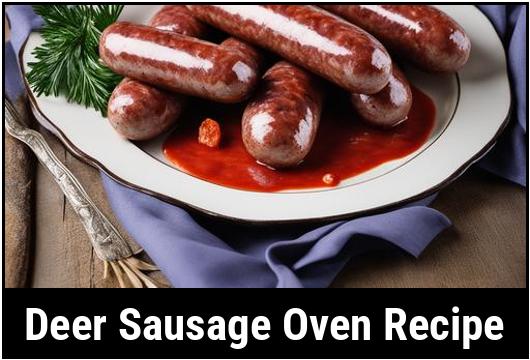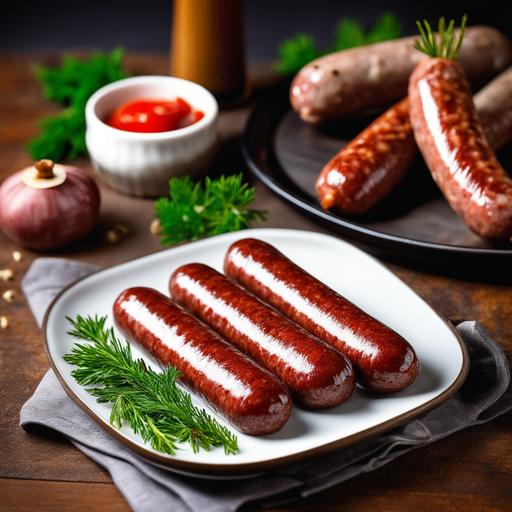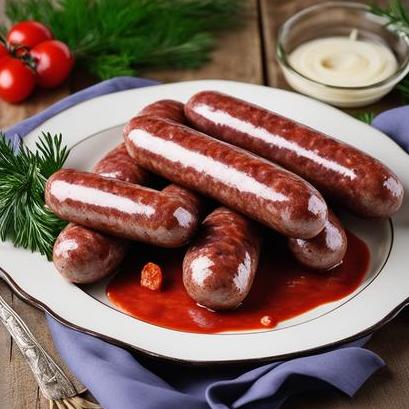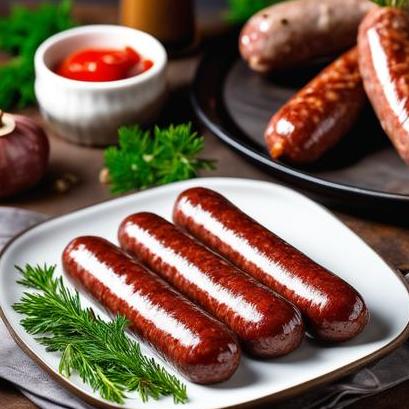
Deer Sausage Oven Recipe: Delicious Delicacy With A Touch Of Wildness
Are you a fan of game meat? Do you enjoy experimenting with new recipes and flavors that take your taste buds on an adventure? If so, you’re in for a treat! In this comprehensive article, we will explore the world of deer sausage and delve into the art of preparing mouthwatering deer sausage in the oven. From understanding the food science behind the cooking process to mastering culinary details, cleaning and preparation techniques, this guide will equip you with all the knowledge you need to make the perfect deer sausage every time.
Understanding the Science behind Deer Sausage Cooking
Before we dive into the delightful details of preparing deer sausage in the oven, let’s take a moment to explore the food science that goes into the cooking process. Understanding the underlying principles will not only enhance your culinary knowledge but also help you perfect your technique.
1. Key Factors Influencing Cooking Results
When cooking deer sausage, several factors contribute to the outcome, including fat content, cooking temperature, cooking time, and level of doneness desired. The fat content in the sausage plays a crucial role in its juiciness and flavor. While deer sausage is typically leaner than pork or beef sausages, adding a small amount of pork fatback or bacon can provide the necessary moisture and richness.
The cooking temperature directly impacts the texture and final doneness of the sausage. Balancing heat is vital to ensure even cooking without drying out the sausage. Additionally, the cooking time will vary based on the size of the sausages and personal preference for doneness. Experimentation is key to finding your perfect balance.
2. Maintaining Food Safety
Following proper food safety guidelines is imperative when preparing any meat, including deer sausage. Start by ensuring your raw materials, such as deer meat and pork fat, are fresh and of high quality. Remember to purchase your meat from trusted sources to minimize the risk of contamination.
During the cleaning and preparation process, practice good hygiene by thoroughly washing your hands, utensils, and work surfaces with warm soapy water. It is crucial to prevent cross-contamination between raw and cooked materials.
When checking the doneness of your deer sausage, make use of a food thermometer. It is recommended to cook the sausages to an internal temperature of 160°F (71°C). This temperature ensures the elimination of any harmful bacteria, leaving you with a safe and enjoyable meal.
Culinary Details: Selecting and Cleaning the Ingredients
Now that we have a solid understanding of the science behind deer sausage cooking, let’s focus on selecting the right ingredients and ensuring they are properly cleaned to maintain both flavor and food safety.
1. Selecting the Meat
Choosing the right meat is crucial for a successful deer sausage oven recipe. Opt for lean cuts of venison, free from any visible tendons or gristle. The meat should possess a vibrant red color and have a clean, fresh smell. It is important to note that the flavor of the venison can vary depending on factors such as the deer’s diet and age. However, the diversity in taste is what makes deer sausage so unique and exciting to savor.
2. Cleaning and Preparing the Ingredients
Before starting the sausage-making process, it is vital to clean and prepare your ingredients properly. Here is a step-by-step guide to ensure your ingredients are safe and ready for the oven:
a. Cleaning the Meat:
-
Trim off any visible silver skin or excessive fat from the venison.
-
Cut the lean venison and pork fatback into small cubes, suitable for grinding.
b. Preparing the Ingredients:
-
Once the meat is trimmed and cubed, partially freeze it for about 30 minutes. This step makes grinding easier and helps maintain the texture of the sausage.
-
While the meat is chilling, prepare the seasonings and spices for your sausage. This is the time to let your creativity shine! Experiment with a variety of flavors, including herbs, spices, garlic, and even a touch of sweetness.
Tips and Tricks for the Perfect Deer Sausage

Mastering the art of preparing deer sausage not only requires culinary knowledge but also relies on tried-and-true tips and tricks that can take your dish from good to outstanding. Below are some suggestions to help elevate your deer sausage oven recipe:
1. Adapting the Seasonings
Understanding that everyone’s taste preferences differ, feel free to adapt and customize the seasonings to your liking. Play around with different combinations of spices and herbs, such as smoked paprika, cayenne pepper, fennel seeds, or thyme. This process allows you to personalize the flavor profile to suit your own culinary style.
2. Binding Agents
Deer meat tends to be leaner than traditional sausages, making it vital to add a binding agent to achieve the desired texture. Common binding agents include bread crumbs, rolled oats, or even cooked rice. The binding agent helps retain moisture and prevents the sausage from becoming dry and crumbly.
3. Sausage Casings
When it comes to sausage casings, the market offers a variety of options. Natural casings, such as hog or sheep intestines, provide a traditional touch and a satisfying snap when bitten into. Alternatively, synthetic casings made from materials like collagen or cellulose are popular for ease of use.
4. Cooking Techniques
While this article focuses on baking sausage in the oven, you do have other cooking options. Grilling or smoking the sausages imparts a delightful smoky flavor. However, oven-baking offers a convenient and simple approach, perfect for beginners and those who don’t have access to grills or smokers.
The Perfect Deer Sausage Oven Recipe

Enough with the preparations and tips! Let’s dive into the core of this article – the ultimate deer sausage oven recipe. Follow the detailed instructions below for a delicious, juicy, and flavorful deer sausage experience.
Ingredients:
-
2 pounds of lean venison, cubed
-
½ pound of pork fatback, cubed
-
2 tablespoons of salt
-
1 tablespoon of ground black pepper
-
2 teaspoons of garlic powder
-
1 teaspoon of paprika
-
1 teaspoon of dried thyme
-
½ teaspoon of cayenne pepper (optional)
-
½ cup of ice water
-
½ cup of bread crumbs (as a binding agent)
-
Sausage casings (as per preference and availability)
Instructions:
-
In a large mixing bowl, combine the cubed venison and pork fatback.
-
In a separate small bowl, mix together the salt, pepper, garlic powder, paprika, dried thyme, and cayenne pepper (if using).
-
Sprinkle the seasoning mixture evenly over the meat, ensuring all pieces are coated. Give it a gentle toss to distribute the flavors.
-
Cover the bowl with plastic wrap and refrigerate for at least 30 minutes to allow the flavors to meld.
-
After the meat has marinated, grind it through a meat grinder fitted with a medium-coarse grinding plate.
-
Once the meat is ground, mix in the bread crumbs and gradually add the ice water. Continue mixing until the meat reaches a sticky consistency.
-
Prepare your preferred sausage casings according to the manufacturer’s instructions. Soak natural casings in water to remove any salt or dryness.
-
Stuff the casing with the sausage mixture, being careful not to overstuff to prevent bursting.
-
Twist the sausage mixture at regular intervals to form individual links.
-
Preheat your oven to 350°F (175°C).
-
Place the sausage links on a baking sheet lined with parchment paper or a wire rack to allow air circulation.
-
Bake the deer sausage in the oven for approximately 25-30 minutes or until the internal temperature reaches 160°F (71°C).
-
Once cooked, allow the sausages to rest for a few minutes before serving. This step allows the juices to redistribute, ensuring a moist and flavorful bite.
-
Serve the deer sausage as desired. You can enjoy them as a standalone dish, incorporate them into pasta sauces or stews, or pair them with your favorite condiments.
Avoiding Undercooking and Overcooking Dilemmas

Achieving a perfectly cooked deer sausage can be a challenging balance. Avoiding both undercooking and overcooking is crucial to achieve a delicious and safe eating experience. Here are some tips to help you overcome these dilemmas:
1. Undercooking Avoidance
-
Invest in a reliable food thermometer. It is an indispensable tool to ensure the sausages reach the recommended internal temperature of 160°F (71°C).
-
Keep track of cooking time. The indicated 25-30 minutes offers a general estimate, but it may vary depending on the size and thickness of the sausages. Always rely on the thermometer as the ultimate doneness indicator.
2. Overcooking Prevention
-
Monitor the sausages closely during the cooking process to prevent them from drying out. Overcooked deer sausage may become tough and lose its juiciness.
-
Adjust the oven temperature if necessary. If you notice the sausages are browning too quickly on the outside while not reaching the desired internal temperature, decrease the oven temperature slightly. This adjustment helps ensure a more even cook.
Variations for an Exquisite Twist

While the classic deer sausage recipe is already a delicacy, there are numerous variations you can explore to add a unique twist. Here are some ideas to spark your culinary creativity:
1. Smoked Deer Sausage
Incorporate a smoky flavor by enhancing the recipe with wood-smoked sea salt or adding a dash of liquid smoke to the seasoning mixture. Additionally, consider using a smoker instead of the oven to impart a rich smokiness that complements the flavors of the venison.
2. Gourmet Deer Sausage
Experiment with premium ingredients such as sun-dried tomatoes, artichoke hearts, or crumbled Feta cheese to elevate the flavor profile and create a gourmet deer sausage that will impress any dinner guest.
3. Spicy Deer Sausage
If you enjoy a little heat, consider adding diced jalapeños or a sprinkle of red pepper flakes to the sausage mixture. This variation infuses the sausage with a spicy kick, adding excitement to every bite.
Conclusion: Savor the Delight of Deer Sausage Perfection
In conclusion, preparing deer sausage in the oven is a delightful culinary adventure that blends the flavors of game meat with your own creative touch. By understanding the food science behind cooking deer sausage, mastering culinary details, and following the cleaning and preparation steps, you will be equipped to create indulgent and savory deer sausages in no time.
Remember to prioritize food safety at every step, maintain good hygiene, and ensure the sausages reach an internal temperature of 160°F (71°C). With the provided recipe, tips, and variations, you are ready to savor the succulent goodness of deer sausage and impress friends and family with your newfound culinary prowess. So gather your ingredients, step into your kitchen, and let the aromas of a delicious deer sausage delight your taste buds!
Sources
FAQS On Deer Sausage Oven Recipe
What Ingredients Do I Need For A Deer Sausage Oven Recipe?
For a deer sausage oven recipe, you will typically need ground deer sausage, salt, pepper, garlic powder, paprika, and any other seasonings of your liking. You will also need a baking dish, aluminum foil, and cooking spray.
How Do I Prepare The Deer Sausage Before Cooking?
Before cooking the deer sausage, remove it from the packaging and pat it dry with paper towels. Then, place the sausage into a large mixing bowl and add in your desired seasonings. Mix the sausage and seasonings together until well combined.
What Is The Cooking Time And Temperature For Deer Sausage In The Oven?
The cooking time and temperature for deer sausage in the oven can vary depending on the recipe. However, a general guideline is to preheat the oven to 350°F and bake the sausage for 20-30 minutes, or until it reaches an internal temperature of 165°F.
Can I Add Vegetables To My Deer Sausage Oven Recipe?
Yes, you can absolutely add vegetables to your deer sausage oven recipe. Some popular options include diced onions, bell peppers, and potatoes. Simply chop the vegetables and mix them in with the seasoned sausage, then bake as directed.
What Can I Serve With My Deer Sausage Oven Recipe?
There are plenty of sides that pair well with deer sausage, such as roasted vegetables, mashed potatoes, or a fresh salad. You could also serve the sausage alongside your favorite grain, such as rice or quinoa, for a well-rounded meal.



